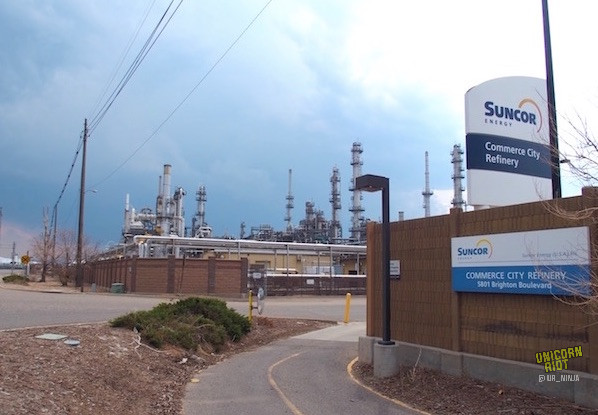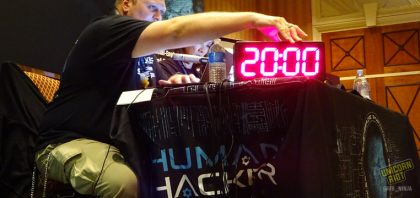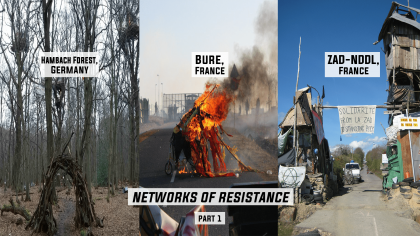“I’m Very Scared and I’m a Sad Mom”: Commerce City Residents Testify at Suncor Refinery Expansion Hearing
Commerce City, CO – On Wednesday evening, August 2, 2017, over 100 residents of Commerce City, Colorado, filled the Suncor Energy refinery public hearing for Suncor’s request for modifying their permits (PDF) to allow for more emissions. Unicorn Riot livestreamed the hearing (full video embedded below).
According to the ‘Notice of Public Comment Hearing’ (PDF) published on June 20, 2017, on the Colorado Air Quality Control Commission website, there was already a “preliminary determination of approval for modifications to the Title V Permit for the Suncor Energy Refinery Plants 1 and 3.”
This public hearing was not initiated by Commerce City’s government, the Colorado Department of Public Health & Environment (CDPHE), nor Suncor, it only happened because the Cross Community Coalition, with and through its counsel Earthjustice, submitted a request for a public comment hearing (PDF) before the Colorado Air Quality Control Commission.
According to the request for the public hearing,
The Suncor Refinery (previously under other ownership) has been found to have repeatedly violated its air pollution permits, and has been subject to numerous enforcement actions as a result.
Frequent accidents have raised significant concerns in neighboring communities, with alarming orange clouds of smoke often seen rising above the refinery from miles away.”
Briana Bradley testified against Suncor at the hearing and explained that she had just recently bought her first house with her husband, which happens to be less than a mile from the refinery.
I’m very scared and I’m a sad mom. I started raising my stepson seven years ago, and his mom took off on him, so my husband and I have tried to give him the absolute best life that we can. . . and I just found out that I’m pregnant. . . and now I’m scared to death.”
Bradley went on to say:
So, I get this sheet tonight with 18 ozone alert days, and I have let my son play in the backyard every single one of those days because I didn’t know. . . Also babies born within a 10-mile radius of one of these plants can suffer upper respiratory problems — which we have heard plenty of stories about tonight — rashes, increased hospitalization — which we’ve also heard about tonight — fatigue, dizziness, vomiting, nose bleeds, and heart defects.”
Another mother, Dina Fuente, testified against the permit modifications because her two children already suffer from asthma, allergies, and other respiratory problems.
We moved to this area five years ago, and in the last two and a half years, it seems like the clinics and the hospitals have been our second home. My youngest was out of school 17 days last year because of asthma.”
During the hearing, which lasted over two hours, about fifty people testified against Suncor’s request, and two people testified in favor.
One of the two who testified in favor was René Bullock, a city council member of Commerce City, who touted Suncor as a “very good community partner in Commerce City,” and said that “Suncor has done a lot of good things in this community.”
He was referring to the funding of the Suncor Boys and Girls Club, the funding to help restore the Sand Creek Regional Greenway (which they also pollute), and the millions of dollars in property tax that the city receives from Suncor every year.
However, as former Suncor Energy refinery worker testified:
I am totally against this emissions’ upgrade. Number one, yes, Suncor donates a lot of money to these communities, but that is just like giving someone a banana split, so you go about what you wanna do.” – Edward Armijo
The Suncor Energy refinery in Commerce City is infamous for air pollution violations, oil spills, and for being a main contributor to the poor air quality in the Denver-metro area, specifically for the zip code 80216.
According to Earthjustice:
The zip code including two nearby neighborhoods, Elyria-Swansea and Globeville, home to high percentages of Latino and low-income residents, was recently identified as the most polluted in the nation based on a set of environmental hazard criteria. Members of this community are suffering from some of the highest rates of asthma, cancer, cardiovascular disease, diabetes and obesity in Colorado.”
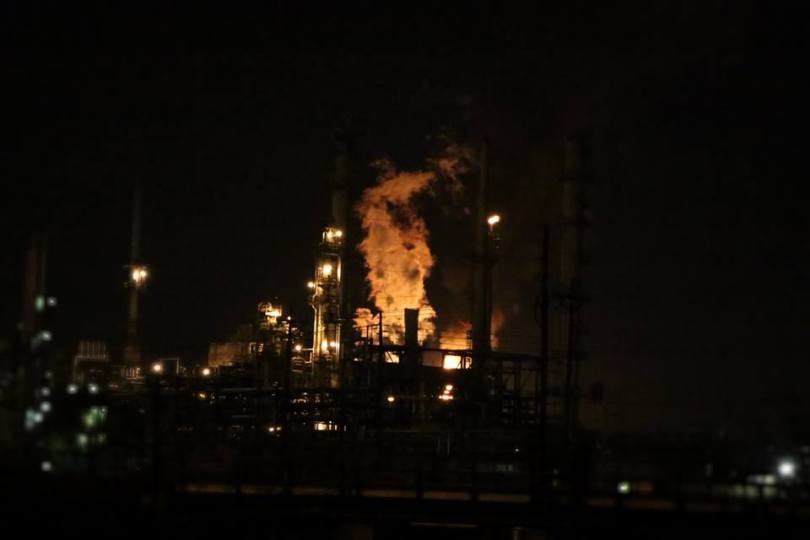
The most recent incident at the refinery happened on March 16, 2017. Because of an Xcel Energy power failure, the refinery released more than 100 pounds of hydrogen sulfide, more than 500 pounds of sulfur dioxide gas, and concentrations up to 1,120 parts per million of carbon monoxide into the air, exceeding state air quality limits.
Only four months prior, on October 14, 2016, another Xcel Energy power failure resulted in the refinery’s release of an estimated 75,600 pounds of sulfur dioxide, which is 150 times greater than the Colorado Department of Public Health and Environment’s (CDPHE) daily limit of 500 pounds. This resulted in road closures, a school lockdown, and a warning to residents to remain indoors.
Sulfur dioxide and hydrogen sulfide are highly toxic byproducts of refining and burning fossil fuels. The Environmental Protection Agency (EPA) has not set a national air quality limit for hydrogen sulfide because any exposure is considered dangerous.
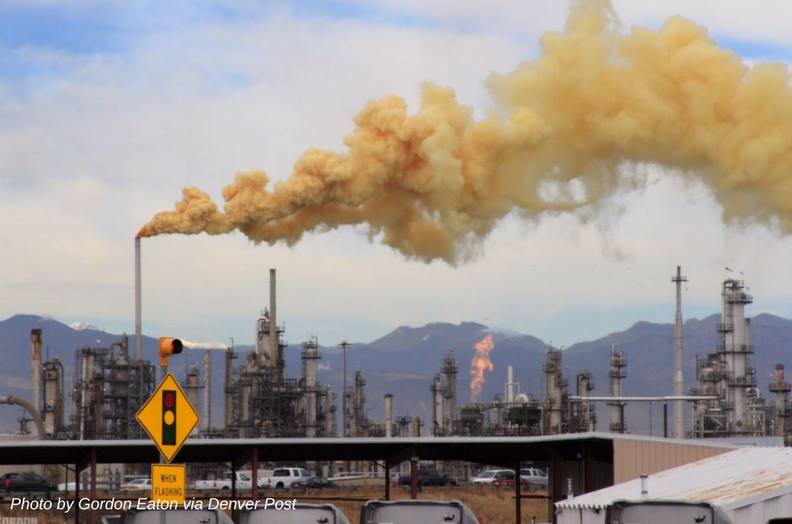
The modifications in emissions that Suncor is requesting are displayed in the chart below:

In the chart, Suncor admits that they have been illegally emitting hydrogen cyanide: “while this is a change in permitted emissions it is not a change in the actual emission rate.”
During the hearing, Joan Seeman, the Colorado Sierra Club’s Toxics Issue Specialist, pointed out that hydrogen cyanide is used in gas chambers.
Other Suncor Refinery mishaps include an oil spill discovered by a fisherman on Sunday, October 27, 2011. Trevor Tanner discovered oil in the Sand Creek flowing into the South Platte River and wrote a blog post about it on his fly fishing blog page:
This morning was awful. I am looking for the words to describe it and can’t. To put it shortly I am absolutely 100% positive I witnessed a petroleum discharge or dump of some kind in Sand-Creek flowing into the South Platte.
This morning at 9:00AM it smelled like a gas station at the Sand-Creek / South Platte confluence. There was also an oily sheen across the entire Sand-Creek side of the South Platte current.”
Tanner called the “Colorado Department of such and such spills / illegal discharges ‘Hotline’ number (877-518-5608)” and over three hours later, he received a call saying that they did not smell anything or see a sheen on the water.
However, the next day on October 29, 2011, EPA emergency response manager Curtis Kimbel visited the site and smelled the oil and saw thick black goo about a mile from the refinery. At that moment he launched an EPA response.
Documents show that CDPHE officials knew about hazardous leakages in the area for at least a month, but did nothing to stop them.

On April 2, 2012, the CDPHE and Suncor Energy completed negotiations over a multitude of air pollution violations at the Commerce City refinery including emissions of benzene.
According to state compliance orders, the benzene emissions between 2008 and 2010 exceeded federal health standards by 3.34 metric tons. A state audit also found that the company failed to replace a broken carbon canister for 710 days.
Under the negotiated settlement, Suncor was shielded from liability and did not admit to violating laws. Mark Salley, the Colorado health department spokesman, said that there was no way to measure the harm resulting from Suncor’s violations.
In November 2013, Suncor agreed to pay $1.9 million to settle a lawsuit about this oil spill by federal and state authorities. According to court documents, the broken pipe that started the spill was capped in February 2011, which was over three months after Tanner discovered the spill.
Cancer-causing benzene seeped into the soil, water, and air during those few months.
According to the Occupational Safety and Health Administration, with benzene exposures
from less than five years to more than 30 years, individuals have developed, and died from, leukemia. Long-term exposure may affect bone marrow and blood production. Short-term exposure to high levels of benzene can cause drowsiness, dizziness, unconsciousness, and death.”
Edward Armijo, a previous employee of Conoco and Suncor from 1985 to 2010, spoke out at the Suncor Refinery hearing:
I worked on all their equipment and when we detect a leak of a VOC (volatile organic compound), you’re supposed to modify the equipment — outdate it. What we were doing is we were using electroclean to clean all these VOC vapors and the oils coming out of the pump, just so they could get to another three months.”
He went on to say,
Now the other deal is the reason they want these emission’s increases: the refinery was built in 1932, we got the oil from Oklahoma or Texas or Wyoming or Colorado. Now they’re going to experiment with what they call the oil sands. That is very, very sour crude. Very corrosive to a point that we were changing out what’s called the pump volute because it was eating up the metal.
If they did not have enough respect to notify me in 2010 that I was sitting on a benzene maintenance shop, which they didn’t, that tells me they don’t care about the public. We’ve been telling them about that smell for years. Look what it took — a fisherman to find oil in the Sand Creek.”
Suncor’s violations are not limited to their Commerce City refinery.
On April 2, 2009, Suncor was fined $675,000 for failing to install pollution control equipment at its Firebag operation near Fort McMurray, Alberta in July 2006. On the same day, Suncor was fined $175,000 for dumping untreated wastewater from a company work camp near Fort McMurray into the Athabasca River in 2007.
The last day to submit final written comments was on Wednesday, August 9, 2017. After this date, the Air Pollution Control Division must grant, deny or modify the permit within 30 days.
The second-to-last person to testify at the hearing was Sky Roosevelt-Morris:
I’m not going to say ‘please’ and I’m not going to say ‘thank you’ because honestly Suncor has no business being here. They didn’t ask the Cheyenne, they didn’t ask the Arapaho, whose territory we’re originally standing on right now according to the 1868 Fort Laramie Treaty. These people are invaders—Suncor. That’s all they’re good for—invading. And when you’re an invader, all you do is lie, cheat, and steal.”
She continued,
1 in 3 Native women will be sexually assaulted or murdered in her lifetime, and Suncor is responsible for that. They are invaders and they are not welcome here, and if you do not hold them accountable, we will. . .
I’m not asking for your permission, this isn’t your homeland, this is my homeland. And I’m not asking anybody’s permission to be on my own homeland, to be able to drink clean water, to breathe clean air, that shouldn’t be revolutionary. To know what’s in your food, to know that you’re breathing clean air, that shouldn’t be a revolutionary act, and unfortunately it is.”
Below is our livestream coverage of the August 2, 2017 hearing:
https://vimeo.com/374869123
https://vimeo.com/374868929
https://vimeo.com/374868005
To help our volunteer-operated, horizontally-organized, non-profit media collective please consider a tax-deductible donation: 
